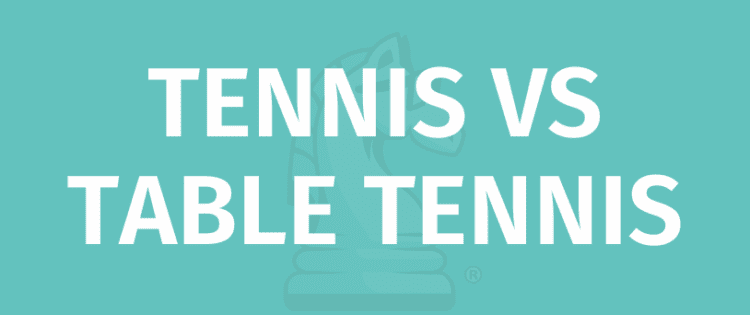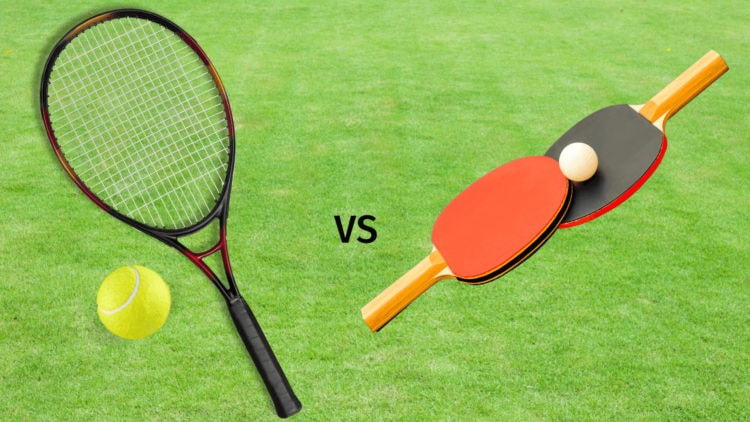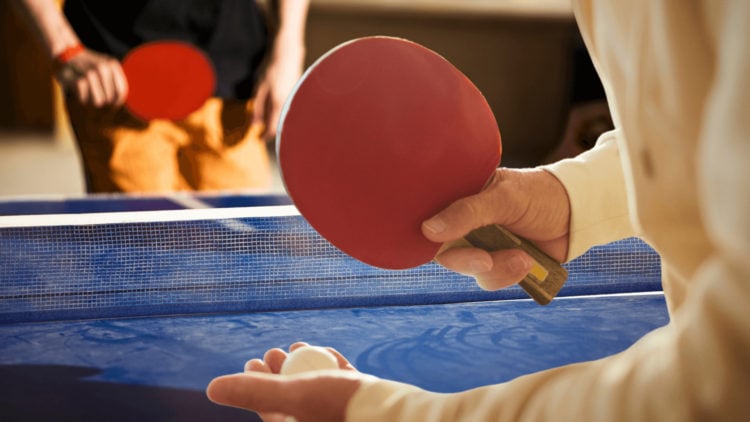
INTRO
Despite both tennis and table tennis fundamentally being the same game played on vastly different scales, it is precisely this scale that differentiates the skills required for each sport.
GAME SPEED
When the scale of a sport shrinks, the pace generally increases as a result. For soccer, a smaller pitch would easily produce far more action and more goals being shot toward the net. Likewise, a smaller basketball court would likely result in a massive uptick in shots being taken and defenders constantly having to play defense. This is exactly what happens when tennis is scaled down to become table tennis differs.
The athleticism and skills required for each sport are vastly different because of this change in pace:
- Tennis requires exceptionally high levels of endurance and strength.
- Table tennis requires very little endurance and strength but instead requires fast reflexes and precise movements.
EQUIPMENT

Both tennis and table tennis involves using a racket to hit a ball onto the opposing player’s side of the net. However, the ball and racket used in these two sports hold stark differences.
TENNIS
Tennis utilizes a heavier ball made of stitched leather or cloth, weighing about 2 ounces and measuring about 2.7 inches in diameter.
A tennis racket is generally 27 inches long, although this measurement can differ between competitions. This racket features a mesh of strings for a racket head.
TABLE TENNIS
A table tennis ball is roughly 20 times lighter than a standard tennis ball and is manufactured out of plastic, and measures only 1.57 inches in diameter.
A table tennis racket, also referred to as a “paddle” or “bat”, measures around 10 inches long. Unlike a tennis racket, this paddle is made entirely of wood and utilizes a solid racket head to hit the ball.
PLAYING SURFACE
TENNIS
A tennis court is 78 feet long and 27 feet wide, or 36 feet wide for doubles matches. The material of the court can vary between venues: clay, grass, hard court, or artificial grass.
TABLE TENNIS
The typical playing surface for table tennis is a plywood table measuring 9 feet in length and 5 feet in width.
ACCESSIBILITY
Simply due to the difference in the equipment necessary to participate in both sports, it shouldn’t be a surprise that table tennis is far more accessible (in both cost and convenience) than tennis.
TENNIS

Although high-caliber rackets can rack up a high price tag, the typical racket and balls needed for tennis are comparable to their table tennis equivalents ($20-50).
The serious price-hike seen with tennis is the cost of space. A tennis court is quite large – most people will never own one in their backyard. Because of this, many people will have to travel to find public courts, many of which cost an hourly rate to rent.
TABLE TENNIS
Table tennis requires similar equipment to tennis at a comparable price ($20-50).
Unlike traditional tennis, table tennis simply requires a “table” to play on. These specialized tables are comparatively affordable and can also be found for free in various public parks and complexes.
Due to the minimal space needed to house a table tennis table, many people own one.
GAMEPLAY
In tennis and table tennis, players hit a ball back and forth over a net until one player fails to hit it back or keep it in the field of play. Although both sports are fundamentally identical in gameplay, a few there are a few noticeable differences between the rules and scoring systems.
SCORING AND DURATION
TENNIS
A typical tennis match can last anywhere from 90-180 minutes. However, matches have been seen to go on for over 5 hours. This length disparity directly results from the sport’s unique scoring system.
Match: The winner of a match is the winner of the entire competition. A match is determined by whoever wins the most “sets”, usually in a best-of-three or best-of-five format.
Set: A player must win six “games” in order to win a set. However, a set must be decided by a margin of at least two games (6:4). If the score becomes tied at 6, a tie-breaker ensues to determine the set winner.
Game: A tennis game utilizes a unique system of scoring:
- 0 points = “Love”
- 1 point = 15
- 2 points = 30
- 3 points = 45
- 4 points = Win*
Similar to the rules regarding sets, a game cannot be decided by less than a 2-point difference. This technically implies a game could last forever (one such game was decided after 138 points!).
TABLE TENNIS

Table tennis scoring is arguably far simpler than traditional tennis. Partly because of this, matches only tend to last 30-60 minutes.
Match: As in tennis, the winner of a match is the victor of the competition. A match is decided by the winner of the most “sets”, usually in a best-of-five or best-of-seven format.
Set: A table tennis “set” is the tennis equivalent of a “game”. Each set is played to 11 points. However, just as in tennis, a player must win by a margin of at least two points.
RULES
Although many meticulous rules exist among these two racket sports, many are insignificant. However, one glaring rule difference concerns “volleys”.
A ‘volley’ refers to hitting a ball in the air before it has touched the ground. In tennis, a player can either:
- hit the ball straight out of the air (volley), or
- after it has bounced once on their side of the court.
In contrast, table tennis requires the ball to bounce one time before a player can return it. In other words, volleying is not allowed in table tennis.
- 30 GAMES TO PLAY OVER TEXT - April 22, 2024
- 20+ FREE PRINTABLE BABY SHOWER GAMES - April 16, 2024
- 20+ College Party Games for the Best Night Ever! - April 2, 2024